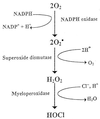Neutrophil chemiluminescence during phagocytosis is inhibited by abnormally elevated levels of acetoacetate: implications for diabetic susceptibility to infections
- PMID: 9729546
- PMCID: PMC95650
- DOI: 10.1128/CDLI.5.5.740-743.1998
Neutrophil chemiluminescence during phagocytosis is inhibited by abnormally elevated levels of acetoacetate: implications for diabetic susceptibility to infections
Abstract
Human neutrophils by a chemiluminescence assay exhibit diminished phagocytic activity in the presence of abnormally high levels of the serum metabolite acetoacetate. These findings, along with our previous evidence demonstrating myeloperoxidase inhibition by acetoacetate, implicate metabolic ketosis in the inhibition of neutrophil microbicidal activity and thus in increased susceptibility to infections.
Figures




Similar articles
-
[Impaired induction of chemiluminescence and function of polymorphonuclear neutrophilic granulocytes in diabetes mellitus].Immun Infekt. 1992 Jul;20(3):91. Immun Infekt. 1992. PMID: 1500077 German.
-
Hypochlorous acid inhibition by acetoacetate: implications on neutrophil functions.Biol Pharm Bull. 2004 Aug;27(8):1183-7. doi: 10.1248/bpb.27.1183. Biol Pharm Bull. 2004. PMID: 15305018
-
Suppression by radiosensitizer AK-2123 of early phorbol myristate acetate-stimulated chemiluminescence response of human neutrophils induced by gamma-irradiation (short communication).Cancer Biother Radiopharm. 1998 Dec;13(6):453-6. doi: 10.1089/cbr.1998.13.453. Cancer Biother Radiopharm. 1998. PMID: 10851438
-
Evidence of ex vivo and in vitro impaired neutrophil oxidative burst and phagocytic capacity in type 1 diabetes mellitus.Diabetes Res Clin Pract. 1993 Mar;19(3):183-8. doi: 10.1016/0168-8227(93)90112-i. Diabetes Res Clin Pract. 1993. PMID: 8319516
-
How has neutrophil research improved our understanding of periodontal pathogenesis?J Clin Periodontol. 2011 Mar;38 Suppl 11:49-59. doi: 10.1111/j.1600-051X.2010.01678.x. J Clin Periodontol. 2011. PMID: 21323704 Review.
Cited by
-
Neutrophils in type 1 diabetes.J Diabetes Investig. 2016 Sep;7(5):652-63. doi: 10.1111/jdi.12469. Epub 2016 Feb 1. J Diabetes Investig. 2016. PMID: 27181374 Free PMC article. Review.
-
Effect of metabolic control on the in vitro proliferation of peripheral blood mononuclear cells in type 1 and type 2 diabetic patients.Sao Paulo Med J. 2006 Jul 6;124(4):219-22. doi: 10.1590/s1516-31802006000400009. Sao Paulo Med J. 2006. PMID: 17086304 Free PMC article.
-
Keratinocyte growth factor augments pulmonary innate immunity through epithelium-driven, GM-CSF-dependent paracrine activation of alveolar macrophages.J Biol Chem. 2011 Apr 29;286(17):14932-40. doi: 10.1074/jbc.M110.182170. Epub 2011 Feb 22. J Biol Chem. 2011. PMID: 21343299 Free PMC article.
-
Beta-hydroxybutyrate abrogates formation of bovine neutrophil extracellular traps and bactericidal activity against mammary pathogenic Escherichia coli.Infect Immun. 2008 Jun;76(6):2802-7. doi: 10.1128/IAI.00051-08. Epub 2008 Apr 14. Infect Immun. 2008. PMID: 18411287 Free PMC article.
-
Absence of occult hepatitis B virus infection in sera of diabetic children and adolescents following hepatitis B vaccination.Hum Vaccin Immunother. 2014;10(8):2336-41. doi: 10.4161/hv.29521. Hum Vaccin Immunother. 2014. PMID: 25424940 Free PMC article.
References
-
- Harrison J E, Saeed F A. Acetoacetate is an electron donor to myeloperoxidase and a promoter of myeloperoxidase-catalyzed fatty acid peroxidation. Biochem Med. 1981;26:339–355. - PubMed
-
- Harrison J E, Saeed F A. ACS Annual Meeting Abstracts. 1981. Acetoacetate: an electron donor and halogen acceptor for neutrophil myeloperoxidase and a promoter of fatty acid peroxidation. - PubMed
-
- Harrison J E, Saeed F A. Radical acetoacetate oxidation by myeloperoxidase, lactoperoxidase, prostaglandin synthetase, and prostacyclin synthetase: implications for atherosclerosis. Biochem Med. 1983;29:149–163. - PubMed
-
- Harrison J E, Schultz J. Studies on the chlorinating mechanism of myeloperoxidase. J Biol Chem. 1976;251:1371–1374. - PubMed
MeSH terms
Substances
LinkOut - more resources
Full Text Sources
Medical
Research Materials

